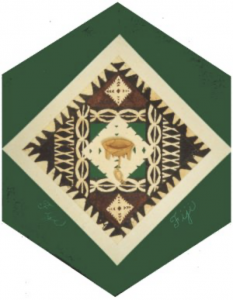Fiji

The Block
A plaited cord, strung with a cowrie shell, dangles from a miniature, hand-carved tanoa (wooden bowl) at the centre of the Fiji block. The design was created and made by Sabina de Stecher and Nancy Douglas, in conjunction with Roy Hiscock and the Fiji Canadian Association. Tanoas, often used in daily life, are traditionally part of the Fijian yaqona ceremony held before important occasions. During the ceremony, the tanoas are filled with a dried yaqona root and water mixture called kava. This drink is also enjoyed on a daily basis at lunchtime or after work. A bilo (cup) is filled and refilled with the kava and shared among the participants. A cord stretches from the tanoa to the guest of honour or chief during ceremonies, symbolically linking the people with their ancestors.
The backdrop is a sample of one of Fiji’s traditional arts, masi. It features a typical saw-toothed edge and geometric patterns. Also known as bark or tapa cloth, masi is fabric made from the inner bark of mulberry trees. It is a labourious process that involves stripping the bark, soaking it in water and then scraping it with shells. Women then pound the bark into thin sheets with wooden mallets, press four layers together, and dry them in the sun to create a light material similar to felt. Finally, using natural dyes, they stencil red, black or brown geometric designs onto the surface. Traditionally used in ceremonial clothing or as gifts, tapa cloth is also made for functional purposes, such as blankets and bedding. It remains an important craft entrenched in every aspect of Fijian life, and its emotional significance and ritual use are still evident today.
Cultural Profile
Fiji, an archipelago in the South Pacific Ocean, is comprised of more than 300 islands, approximately 100 of which are inhabited. Captain James Cook was among the first visitors here, but major credit for the discovery and charting of the islands went to Captain William Bligh, of the famous ship The Bounty. Historically, sugar cane dominated Fiji’s economy and it continues to be the country’s largest export. Indigenous Fijians (Melanesian and Polynesians), making up more than half the population, are the major ethnic group. The second largest sector is the East Indians. The official language is English, although when with one another, ethnic Fijians usually speak Fijian and most Indians speak Hindi.
Fijians are friendly, hospitable people who will often invite guests to stay in their homes. Village life is communal, adults care for all the children, and everyone is expected to share in ceremonial preparation, village upkeep or activities that benefit all, such as fish drives. Gift-giving is an essential part of Fijian life and anyone refusing a gift risks offending the giver. A tabua (polished sperm whale tooth) offered as a gesture of welcome, respect or sympathy, is the most precious gift, and to receive a tabua is one of Fiji’s highest honours. The recipient, however, is expected to continue the tradition by later presenting it to someone else.
In a country with a rich cultural heritage, Fijian history, myths and legends are kept alive through music and dance. The Meke, a traditional spiritual dance passed down from generation to generation, involves re-enacting heroic or tragic passed events. The country is also famous for its choral singing. Musical instruments specific to Fiji include the lali drum, made of a hollowed out tree. These were once used as talking drums to announce births, deaths and wars, and serve today to call people to meetings such as church services. Guitars, ukuleles and mandolins are also featured extensively in the Fijian music.
Traditionally, arts and crafts in Fiji are divided between men and women. For example, Fijian women weave mats and basket with pandanus leaves, banana stems, or the prized kuta grass. They also shape pottery with a paddle, without using a wheel, and make masi cloth that can be used in the home or sold for extra money. Men weave baskets and use their renowned woodcarving skills to produce objects such as the tanoa. The country’s police and military forces band members are also recognized the world over by their uniforms of sulu (woven cloth) skirts with tooth-like pointed hems, worn with short jackets.
Fijians have been coming to Canada for mainly economic reasons, from 1964 onwards. Bringing with them a variety of skills, they settled in Ontario and British Columbia. There are currently over 20,000 Fijians living in Canada.
Sponsor: Del and John Roulston
